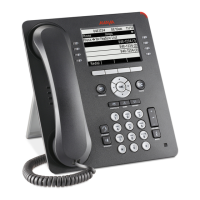Administration Overview and Requirements
26 Deskphone SIP 9608, 9611G, 9621G, 9641G Administrator Guide Release 6.0.1
Step 2: DHCP processing
If an IP address has not been manually configured in the telephone, the telephone initiates
DHCP, as described in Administering the DHCP and File Servers
on page 63. Among other
data passed to the deskphone is the IP Address of the HTTP or HTTPS server.
Step 3: Downloading files
The 9600 Series IP Deskphones can download configuration files, certificate files, and
language files from either an HTTP or HTTPS server but they can only download software files
from an HTTP server. The telephone first downloads an upgrade configuration file, which tells
the telephone which software files it should use. The telephone then downloads a settings
configuration file, and based on those settings, it may then download language files and/or
certificate files. Finally, the telephone will download one or two new software files, depending on
whether or not the software in the telephone is the same as that specified in the upgrade file.
For more information about this download process and settings file, see. Chapter 7:
Telephone
Software and Application Files.
Step 4: Registering with the SIP proxy server
In this step, the deskphone might prompt the user for an extension and password. The
deskphone uses that information to exchange a series of messages with SES/SM, which in turn
communicates with Avaya Communication Manager (CM). For a new installation and for full
service, the user can enter the deskphone extension (in SES environments only) and the SES/
SM password. For a restart of an existing installation, this information is already stored on the
deskphone, but the user might have to confirm that information. The deskphone and SES or
SM, and SES/SM and CM exchange more messaging. The expected result is that the
deskphone is appropriately registered and call server data such as feature button assignments
are downloaded.
!
Important:
Important:
For SES, the user name is the extension. For Session Manager, the user name
takes the canonical address format that uniquely identifies a user across all
Enterprise sites; see the white paper titled Avaya Aura
®
6.0 Configuration for
Presence and IM on the Avaya support Web site.
For more information about the installation process, see the Avaya one-X™ Deskphone SIP
Installation and Maintenance Guide for 9608, 9611G, 9621G, and 9641G Deskphones
(Document Number 16-603604).

